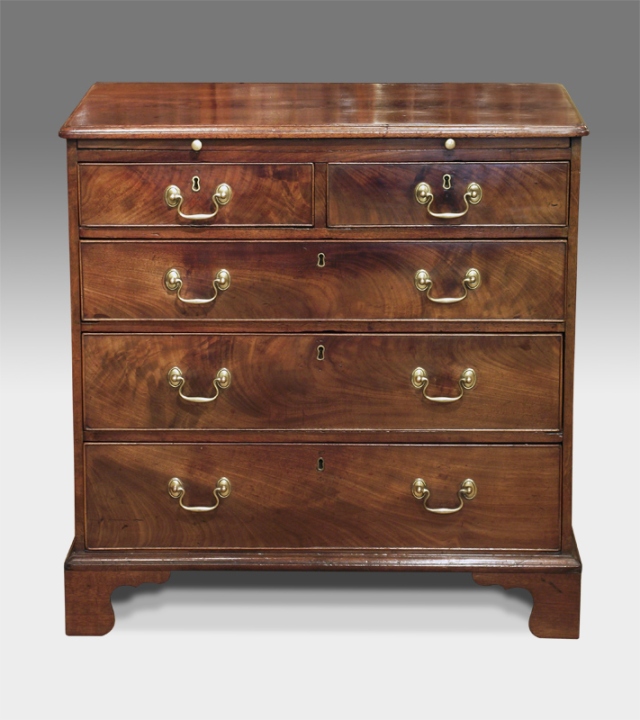Chests with equal length drawers can be so easily let down by inconsiderately placed handles. At first glance, one could be forgiven for thinking the chest in figure 1 was ‘cut-and-shut’ to fit within the confines of an alcove or some such: The handles are so close to the ends of the drawers. However, it was undoubtedly made that way.
 Fig. 1. George III mahogany chest, circa 1780. (Thakeham Furniture)
Fig. 1. George III mahogany chest, circa 1780. (Thakeham Furniture)
The broadly employed maxim that handles should be located on the first and third quarter divisions of a drawer front – the escutcheons being placed on the second division – appears typically ‘woodworking magazine’ (fig. 2) and equally as awkward as figure 1.
 Fig. 2. George III mahogany chest, circa 1780. (Thakeham Furniture)
Fig. 2. George III mahogany chest, circa 1780. (Thakeham Furniture)
The most visually pleasing arrangement is seen on chests with two short drawers above a bank of long drawers (fig. 3). The vertical alignment of the handles is naturally dictated by the centres of the short drawers which are only off-set from the chest’s centreline by half the width of the vertical drawer divider.
 Fig. 3. George III mahogany chest, circa 1780. (Thakeham Furniture)
Fig. 3. George III mahogany chest, circa 1780. (Thakeham Furniture)
When the same axiom is applied to chests with equal length drawers, the result is perfection (fig. 4).
 Fig. 4. George III mahogany chest, circa 1780. (Thakeham Furniture)
Fig. 4. George III mahogany chest, circa 1780. (Thakeham Furniture)
Jack Plane

Hard to imagine that 3/8 to 1/2 inch could make such an improvement!
Regards,
Mike
LikeLike
I never really noticed that until now.
Thank you Jack.
This is why I keep coming back.
(Hope the shop restoration has gone well.)
LikeLike
Excellent observation & great examples. Proportion is vitally important. Thanks
LikeLike
Yes, that last chest is spot on. Do you have a similar guideline for the vertical placing of the handles on each drawer?
LikeLiked by 1 person
I presume you mean the horizontal placement of handles, which is more complicated. Knobs and some rings and small drops are straightforward as their relative concentricity means they can be placed exactly on-centre – where ever that may be.
Fretted backplates, swan neck bails with circular backplates, and larger drops present problems as their centrelines can be arbitrary. En suite fretted escutcheons can cause additional issues as the key hole locations are dictated by the positions of the locks’ drill pins which, on shallow upper drawers, often means the most southerly points of the backplates come close to the bottom edges of the drawers.
I’m afraid I don’t have a formula for the horizontal placement of handles which is why it’s imperative to study original pieces, identify those that are ‘right’ and learn from them. Blindly using ones’ own (if uneducated) discretion usually leads to much rue and gnashing of teeth.
JP
LikeLike
Thanks JP.
LikeLike
It does not seem amazing until it is pointed out to you.
LikeLike
Brilliant! This is the best explanation/demonstration I’ve seen in this matter. Hats off.
LikeLike
so the distance between the handle fittings is approximately half the width of the piece. How about the proportions of the heights of the drawers? Golden mean? Fibbonaci ?
LikeLike
I am conversant with the golden ratio and Fibonacci sequence, but I am yet to be convinced either was employed by seventeenth- or eighteenth-century British cabinetmakers. I haven’t encountered any evidence of their use.
As can be seen in the images above, getting it ‘right’ requires keen observation and a good eye. The best looking chests defy all geometric formulae.
Some mid-eighteenth-century chests followed the 5-6-7-8 rule which only works if the chest’s proportions are ‘right’, but generally, successful drawer sizing is pure art.
JP
LikeLike
While I agree with your observations, wouldn’t the spacing of the handles on the 2nd example have looked more acceptable if there was no escutcheon and it just had simple key holes like the other examples?
It is the space between items that impacts our impressions and this affected by both the placement and the size of the items.
P.S. If I was handy with photo editing I would have tested this empirically before posting, but unfortunately I don’t have those skills.
LikeLike
The placement of the brasses should be pleasing to the eye irrespective of whether the escutcheons are the fretted plate type or simple wire variations.
Wire escutcheons on the example in figure 2 wouldn’t ‘correct’ the placement of the handles.
JP
LikeLike
Thankyou for this well timed information. Do you have any advice on locating handles on a chest with two rows of three drawers at the top, then three rows of two drawers below? The overall width is 1600mm.
LikeLike
The overall width of the chest is immaterial; the key to the right look is the proportions of the three top drawers. If they are of equal width, then have a look at the cabinet drawers (behind a pair of doors) of a secretaire cabinet as they often have a 3-2-1 lay-out.
The most appealing 3-2-1 lay-out I’ve seen is that of some country dressers where the centre drawer is wider than those either side of it, but narrower than the two immediately below it. The top outer drawers have a single, central handle which align with the outer handles of the subjacent drawers and the handles of the centre drawer align with the inner handles of the subjacent drawers. It balances just perfectly.
JP
LikeLike
The rows of three are equal width. I have taken your advice and had a look at some secretaire cabinets and will have to have a play. Thankyou for your advice.
LikeLike
Pingback: Proportion, Formulae and Aesthetics | Pegs and 'Tails
Pingback: Picture This CXXIV | Pegs and 'Tails